Artículos SCI
2012
2012
Materiales Nanoestructurados y Microestructura
An international round-robin calibration protocol for nanoindentation measurements
Cabibbo, M; Ricci, P; Cecchini, R; Rymuza, Z; Sullivan, J; Dub, S; Cohen, SMicron, 43 (2012) 215-222 DOI: 10.1016/j.micron.2011.07.016
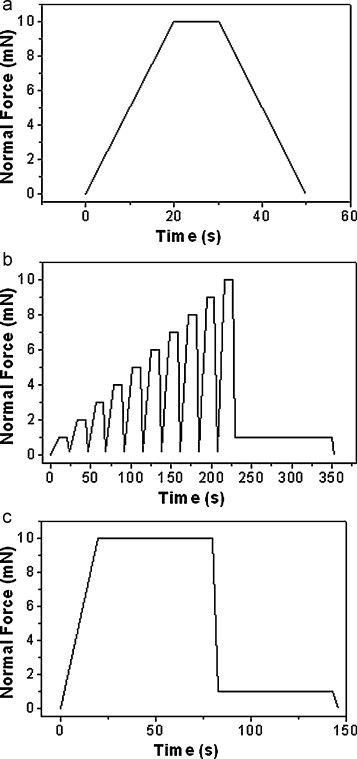
Abstract
Nanoindentation has become a common technique for measuring the hardness and elastic–plastic properties of materials, including coatings and thin films. In recent years, different nanoindenter instruments have been commercialised and used for this purpose. Each instrument is equipped with its own analysis software for the derivation of the hardness and reduced Young's modulus from the raw data. These data are mostly analysed through the Oliver and Pharr method. In all cases, the calibration of compliance and area function is mandatory. The present work illustrates and describes a calibration procedure and an approach to raw data analysis carried out for six different nanoindentation instruments through several round-robin experiments. Three different indenters were used, Berkovich, cube corner, spherical, and three standardised reference samples were chosen, hard fused quartz, soft polycarbonate, and sapphire. It was clearly shown that the use of these common procedures consistently limited the hardness and reduced the Young's modulus data spread compared to the same measurements performed using instrument-specific procedures. The following recommendations for nanoindentation calibration must be followed: (a) use only sharp indenters, (b) set an upper cut-off value for the penetration depth below which measurements must be considered unreliable, (c) perform nanoindentation measurements with limited thermal drift, (d) ensure that the load–displacement curves are as smooth as possible, (e) perform stiffness measurements specific to each instrument/indenter couple, (f) use Fq and Sa as calibration reference samples for stiffness and area function determination, (g) use a function, rather than a single value, for the stiffness and (h) adopt a unique protocol and software for raw data analysis in order to limit the data spread related to the instruments (i.e. the level of drift or noise, defects of a given probe) and to make the H and Er data intercomparable.
Febrero, 2012 · DOI: 10.1016/j.micron.2011.07.016
Materiales de Diseño para la Energía y Medioambiente
Effect of oxidation on the compressive strength of sintered SiC-fiber bonded ceramics
Ramirez-Rico, J; Martinez-Fernandez, J; Singh, MMaterials Science and Engineering A, 534 (2012) 394-399 DOI: 10.1016/j.msea.2011.11.085
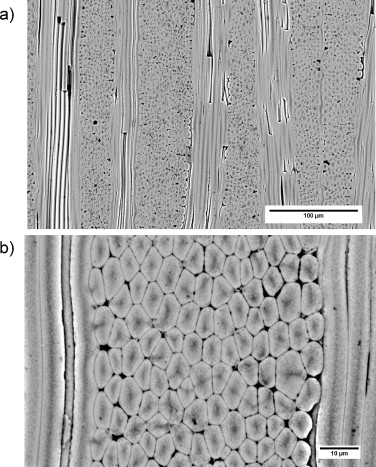
Abstract
The compressive strength of SiC-fiber bonded ceramics obtained from hot-pressed amorphous Si-Al-C-O fibers and its degradation by high temperature exposure to an oxidizing environment was studied. Compressive strength was measured at room temperature as a function of strain rate, orientation, and oxidation temperature. Weight loss was monitored as a function of exposure time in atmospheric air at temperatures ranging from 800 to 1600°C, for times ranging from 0.5 to 5. h. Room-temperature compressive strength had a moderate decrease after exposures at 800°C associated to carbon burnout; increased for exposures in the range 1000-1500°C due to a defect-blunting action of the silica scale; and decreased significantly at 1600°C due to extensive surface recession.
Febrero, 2012 · DOI: 10.1016/j.msea.2011.11.085
Nanotecnología en Superficies y Plasma - Materiales Nanoestructurados y Microestructura - Tribología y Protección de Superficies
Magnetron sputtered a-SiO xN y thin films: A closed porous nanostructure with controlled optical and mechanical properties
Godinho, V; Rojas, TC; Fernandez, AMicroporous and Mesoporous Materials, 149 (2012) 142-146 DOI: 10.1016/j.micromeso.2011.08.018
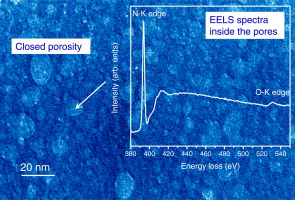
Abstract
Amorphous silicon oxynitride coatings with similar composition and different closed porosity were prepared by magnetron sputtering. Pores size, shape and distribution were evaluated by scanning electron microscopy and transmission electron microscopy. Raman and EELS analysis proved that the pores are filled with molecular nitrogen trapped during deposition. The mechanical properties evaluated by nanoindentation shows that the presence of closed nano-porosity does not compromise the mechanical integrity of these coatings. The introduction of closed porosity is shown as a good strategy for obtaining lower dielectric constant silicon oxynitride coatings with similar composition while keeping the good mechanical properties (∼13 GPa) characteristic of this type of coatings. The presence of close porosity gives also a good stability of coatings properties as compared to open porosity microstructures where gas phase in contact with the coatings can affect coatings properties.
Febrero, 2012 · DOI: 10.1016/j.micromeso.2011.08.018
Materiales y Procesos Catalíticos de Interés Ambiental y Energético
In Situ XAS Study of Synergic Effects on Ni-Co/ZrO2 Methane Reforming Catalysts
Gonzalez-delaCruz, VM; Pereniguez, R; Ternero, F; Holgado, JP; Caballero, AJournal of Physical Chemistry C, 116 (2012) 2919-2926 DOI: 10.1021/jp2092048

Abstract
Four different mono and bimetallic Ni–Co/ZrO2 catalysts have been studied by means of in situ XAS, X-ray diffraction, TPR, and measurements of the catalytic activity in the dry reforming reaction of methane (DRM). Even though the cobalt monometallic system has no activity for the methane reforming reaction, both bimetallic catalysts (with 1:1 and 1:2 Ni/Co ratio, respectively), showed a better activity and stability than the nickel monometallic system. The XRD data indicate that a mixed cobalt–nickel spinel is formed by calcination of the precursor solids, leading to the formation of an alloy of both metals after reduction in hydrogen. In situ XAS experiments showed a much better resistance of metals in the bimetallic systems to be oxidized under reaction conditions at temperatures until 750 °C. After these results, we proposed the formation in the bimetallic systems of a more reducible nickel–cobalt alloy phase, which remains completely metallic in contact with the CO2/CH4 reaction mixture at any temperature. The presence of adjacent nickel and cobalt sites seems to avoid the deactivation of cobalt in the DRM reaction. In the case of cobalt sites, the presence of adjacent nickel atoms seems to prevent the deposition of carbon over the cobalt sites, now showing its higher activity in the dry reforming reaction. Simultaneously, this higher activity of the cobalt sites in the bimetallic system produces more hydrogen as a product, maintaining the nickel atoms completely reduced under reaction conditions. This synergic effect accounts for the better performance of the bimetallic systems and points at both, the oxidation state of nickel particles under reaction conditions and the carbon deposition processes, as important factors responsible for differences in catalytic activities and stabilities in this hydrocarbon reaction.
Febrero, 2012 · DOI: 10.1021/jp2092048
Materiales Nanoestructurados y Microestructura - Tribología y Protección de Superficies - Materiales Coloidales
Microwave-Assisted Synthesis and Luminescence of Mesoporous REDoped YPO4 (RE = Eu, Ce, Tb, and Ce plus Tb) Nanophosphors with Lenticular Shape
Rodriguez-Liviano, S; Aparicio, FJ; Rojas, TC; Hungria, AB; Chinchilla, LE; Ocana, MCrystal Growth and Design, 12 (2012) 635-645 DOI: 10.1021/cg201358c

Abstract
Mesoporous tetragonal RE:YPO 4 nanophosphors (RE = Eu, Ce, Tb, and Ce + Tb) with a lenticular morphology, narrow size distribution, and high surface area have been prepared by an homogeneous precipitation procedure consisting of aging, at low temperature (80-120 °C) in a microwave oven, ethylene glycol solutions containing only yttrium acetylacetonate and phosphoric acid. This synthesis method involves important advantages such as its simplicity, rapidness (reaction time = 7 min), and high reaction yields. The mechanism of nanoparticle growth has been also addressed finding that the lenticular nanoparticles are formed through an ordered aggregation of smaller entities, which explains their porosity. In all cases, the doping levels were systematically varied in order to optimize the nanophosphors luminescence. All optimum nanophosphors presented a high luminescence quantum yield (QY). In particular, for the Eu and Tb doped systems, the obtained QY values (60% for Eu and 80% for Tb) were the highest so far reported for this kind of nanomaterial. The morphological, microstructural, and luminescent properties of these nanophosphors and their dispersibility in water make them suitable for biomedical applications.
Febrero, 2012 · DOI: 10.1021/cg201358c
Materiales Nanoestructurados y Microestructura
Analysis and application of the theories that rationalize the crystalline structures of fluorite-related rare earth oxides
Lopez-Cartes, C; Perez-Omil, JA; Rodriguez-Izquierdo, JM; Calvino, JJCatalysis Today, 180 (2012) 161-180 DOI: 10.1016/j.cattod.2011.04.032
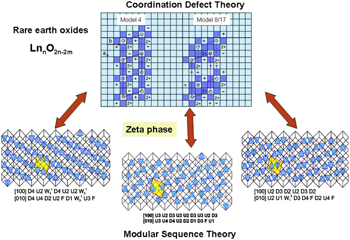
Abstract
The main current theories dealing with the crystalline structures of the fluorite related rare earth oxides, including those corresponding to reduced oxides, one based on the distribution of the coordination defect inside the fluorite structure, and the other which proposes the establishment of modular sequences constituted by modules with fluorite structure, are presented and comparatively explored in detail. Our in-depth analysis of both approximations indicates that they in fact provide smart and efficient rationalizations of the currently known intermediate rare earth oxides structures. We prove however that the strict application of the principles and rules proposed by each theory does not yield unique and unambiguous results for most of the members of the homologous series, as it has been claimed up to now. Moreover, the controversy about the reliability of these two, apparently different and competing, theories is definitely clarified and the exact equivalence of their structural predictions is demonstrated. Finally, we propose new extra systematization rules, not considered up to now in neither of these theoretical approaches, to overcome the observed limitations to properly rationalize the structure of this so technologically important family of oxides.
Enero, 2012 · DOI: 10.1016/j.cattod.2011.04.032
Fotocatálisis Heterogénea: Aplicaciones
Photocatalytic Ethanol Oxidative Dehydrogenation over Pt/TiO2: Effect of the Addition of Blue Phosphors
Murcia, JJ; Hidalgo, MC; Navio, JA; Vaiano, V; Ciambelli, P; Sannino, DInternational Journal of Photoenergy, 2012 (2012) 687262 DOI: 10.1155/2012/687262
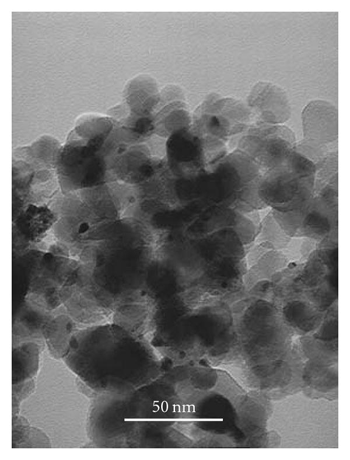
Abstract
Ethanol oxidative dehydrogenation over Pt/TiO2 photocatalyst, in the presence and absence of blue phosphors, was performed. The catalyst was prepared by photodeposition of Pt on sulphated TiO2. This material was tested in a gas-solid photocatalytic fluidized bed reactor at high illumination efficiency. The effect of the addition of blue phosphors into the fluidized bed has been evaluated. The synthesized catalysts were extensively characterized by different techniques. Pt/TiO2 with a loading of 0.5 wt% of Pt appeared to be an active photocatalyst in the selective partial oxidation of ethanol to acetaldehyde improving its activity and selectivity compared to pure TiO2. In the same way, a notable enhancement of ethanol conversion in the presence of the blue phosphors has been obtained. The blue phosphors produced an increase in the level of ethanol conversion over the Pt/TiO2 catalyst, keeping at the same time the high selectivity to acetaldehyde.
Enero, 2012 · DOI: 10.1155/2012/687262
Materiales y Procesos Catalíticos de Interés Ambiental y Energético
Mechanism of complete n-hexane oxidation on silica supported cobalt and manganese catalysts
Todorova, S; Naydenov, A; Kolev, H; Holgado, JP; Ivanov, G; Kadinov, G; Caballero, AApplied Catalysis A-General, 413-414 (2012) 43-51 DOI: 10.1016/j.apcata.2011.10.041

Abstract
Mono- and bi-component cobalt and manganese samples were prepared by impregnation of silica with aqueous solutions of Co(NO3)2·6H2O and/or Mn(NO3)2·6H2O. The bi-component samples were obtained by a common solution of Co- and Mn nitrates (CoMn-MS) or by deposition of cobalt on calcined Mn sample (Co + Mn). The catalysts were characterized by X-ray diffraction (XRD), scanning electron microscopy (SEM), temperature programmed reduction (TPR), Fourier transformed infrared (FTIR) spectroscopy, X-ray photoelectron spectroscopy (XPS), elemental analysis and tested in reaction of complete n-hexane oxidation. It was observed that the well crystalline cobalt oxide partially covers poorly crystalline manganese oxide in the Co + Mn catalysts, while finely divided oxides (MnO2 and Mn2O3, Co3O4) are present on the surface of the (CoMn-MS) sample. Four Langmuir–Hinshelwood and two Mars–van Krevelen models were fitted with the experimental data from the catalytic tests. According to the model calculations and results from instrumental methods, the reaction pathway over single component manganese and bi-component Co-Mn catalysts proceeds through Mars–van Krevelen mechanism (the oxidation of the catalyst surface being the rate determining step), while Langmuir–Hinshelwood mechanism is more probable for the Co sample. A considerable increase in activity for the sample obtained from a mixed solution is explained by low crystallinity, simultaneous presence of Mn4+–Mn3+ and enrichment of the surface in oxygen species.
Enero, 2012 · DOI: 10.1016/j.apcata.2011.10.041
Redox and catalytic properties of CuO/CeO2 under CO + O2 + NO: Promoting effect of NO on CO oxidation
Martinez-Arias, A.; Hungria, A. B.; Iglesias-Juez, A.; Fernandez-Garcia, M.; Anderson, J. A.; Conesa, J. C.; Munuera, G.; Soria, J.Catalysis Today, 180 (2012) 81-87 DOI: 10.1016/j.cattod.2011.02.014
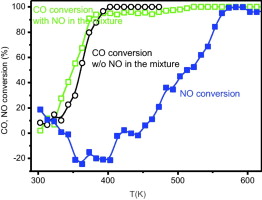
Abstract
A CuO/CeO2 catalyst has been studied with respect to its catalytic activity for CO oxidation under stoichiometric conditions employing either O2 or O2–NO mixture as oxidants. The obtained results are rationalised on the basis of analysis of redox properties upon interaction with CO and O2–NO by EPR as well as by redox/catalytic analysis by operando-DRIFTS. These provide useful insight into the processes involved during NO reduction, for which two well differentiated steps associated to a change in the type of active centres during the course of the reaction are evidenced. Nevertheless, the most interesting result is related to observation of a novel promoting effect of NO on CO oxidation. This is explained mainly on the basis of DRIFTS results and appears to be associated with phenomena of adsorption/desorption of NOx species at interfacial positions which apparently activate such interfacial region allowing formation of greater amounts of active reduced copper centres in the presence of NO.
Enero, 2012 · DOI: 10.1016/j.cattod.2011.02.014
Materiales de Diseño para la Energía y Medioambiente
Aluminum incorporation in alpha-PbO2 type TiO2 at pressures up to 20 GPa
Escudero, A; Langenhorst, FPhysics of the Earth and Planetary Interiors, 190 (2012) 87-94 DOI: 10.1016/j.pepi.2011.11.002
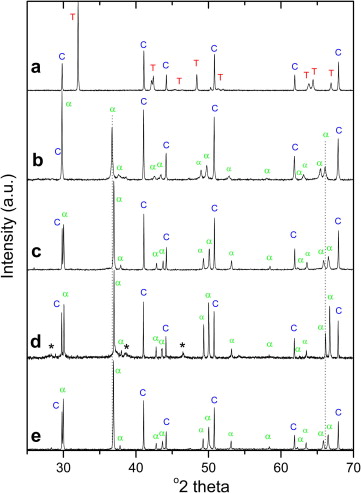
Abstract
Aluminum incorporation into the high pressure polymorph of TiO2 with the structure of alpha-PbO2 has been studied from 10 to 20 GPa and 1300 degrees C by XRD, high-resolution Al-27 MAS-NMR and TEM. Al-doped alpha-PbO2 type TiO2 can be recovered at atmospheric pressure. Al2O3 solubility in alpha-PbO2 type TiO2 increases with increasing the synthesis pressure. The alpha-PbO2 type TiO2 polymorph is able to incorporate up to 35 wt.% Al2O3 at 13.6 GPa and 1300 degrees C, being the substitution of Ti4+ by Al3+ on normal octahedral sites and the formation of oxygen vacancies the mechanism of solubility. The transition to the higher pressure TiO2 polymorph with the ZrO2 baddeleyite structure, akaogiite, has not been observed in the quenched samples at room pressure. The microstructure of the recovered sample synthesized at 16 GPa and 1300 degrees C points to the existence of an intermediate non-quenchable aluminum titanium oxide phase at these conditions.
Enero, 2012 · DOI: 10.1016/j.pepi.2011.11.002
Reactividad de Sólidos
Characterisation of ternary TixV1-xNy nitride prepared by mechanosynthesis
Roldan, MA; Alcala, MD; Real, CCeramics Intenational, 38 (2012) 687-693 DOI: 10.1016/j.ceramint.2011.07.057
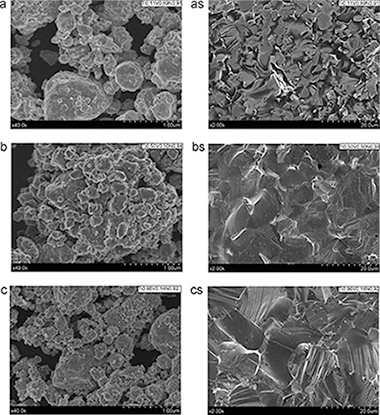
Abstract
In the present manuscript the authors have systematically investigated the composition and microstructure of a series of ternary nitrides (TixV1-xNy) (0.0 <= x <= 1.0) prepared by mechanosynthesis, using XRD, SEM, EELS, XAS and TGA. The ternary titanium-vanadium nitride (TixV1-xNy) has been obtained in all range of compositions by the mechanical treatment of the two metals under nitrogen pressure in a planetary mill with a maximum milling time of 3 h and without any post-heating treatment. The materials' microhardnesses were measured after sinterisation and compared to those reported in the literature for these types of materials. When compared with the previously reported data for bulk samples, these values are similar or higher for compositions within the range x = 0.5 to x = 0.77 (TixV1-xN).
Enero, 2012 · DOI: 10.1016/j.ceramint.2011.07.057
Materiales y Procesos Catalíticos de Interés Ambiental y Energético
Effect of hydrothermal treatment on structural and photocatalytic properties of TiO2 synthesized by sol-gel method
Melian, EP; Diaz, OG; Rodriguez, JMD; Colon, G; Navio, JA; Pena, JPApplied Catalysis A-General, 411 (2012) 153-159 DOI: 10.1016/j.apcata.2011.10.033
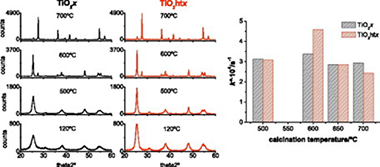
Abstract
TiO 2 nanoparticles have been prepared by sol-gel precipitation and further hydrothermal treatment. In this way, the effect of the hydrothermal treatment on the structural properties and photocatalytic activity of sol-gel synthesized catalysts has been investigated. These catalysts have been produced by hydrolysis of a mixture of isopropanol-titanium tetraisopropoxide (iPrOH-TiiP). The prepared photocatalysts were characterized by means of X-ray diffraction (XRD), surface area analysis (BET), transmission microscopy (TEM), thermogravimetric analysis (TG), scanning electron microscopy (SEM) analysis, diffuse reflectance, sedimentability analysis and aggregate size study. Besides, the structural evolution with the temperature of the photocatalysts treated or not hydrothermally was studied. It was observed that the calcination produces approaching between the characteristics of both sets of photocatalysts. The photocatalytic activity of the obtained photocatalysts was investigated, using phenol as a model pollutant. The calcination temperature is the most remarkable factor that can affect the ultimate photocatalytic activity of the prepared photocatalysts. However, the hydrothermal treatment previous to calcination led to obtain photocatalysts which exhibit larger photocatalytic activity than their homologous photocatalysts without hydrothermal treatment. The obtained photocatalyst TiO 2ht600 exhibits the same photocatalytic activity per surface area than the commercial TiO 2 Degussa P25 but with much faster sedimentability.
Enero, 2012 · DOI: 10.1016/j.apcata.2011.10.033
XRF, μ-XRD and μ-spectroscopic techniques for revealing the composition and structure of paint layers on polychrome sculptures after multiple restorations
Franquelo, ML; Duran, A; Castaing, J; Arquillo, D; Perez-Rodriguez, JLTalanta, 89 (2012) 462-469 DOI: 10.1016/j.talanta.2011.12.063

Abstract
This paper presents the novel application of recently developed analytical techniques to the study of paint layers on sculptures that have been restored/repainted several times across centuries. Analyses were performed using portable XRF, μ-XRD and μ-Raman instruments. Other techniques, such as optical microscopy, SEM-EDX and μ-FTIR, were also used. Pigments and other materials including vermilion, minium, red lac, ivory black, lead white, barium white, zinc white (zincite), titanium white (rutile and anatase), lithopone, gold and brass were detected. Pigments from both ancient and modern times were found due to the different restorations/repaintings carried out. μ-Raman was very useful to characterise some pigments that were difficult to determine by μ-XRD. In some cases, pigments identification was only possible by combining results from the different analytical techniques used in this work. This work is the first article devoted to the study of sculpture cross-section samples using laboratory-made μ-XRD systems.
Enero, 2012 · DOI: 10.1016/j.talanta.2011.12.063
Materiales Nanoestructurados y Microestructura
Nanoscale mechanically induced structural and electrical changes in Ge 2Sb 2Te 5 films
Cecchini, R; Benitez, JJ; Sanchez-Lopez, JC; Fernandez, AJournal of Applied Physics, 111 (2012) 016101 (3 pages) DOI: 10.1063/1.3673592
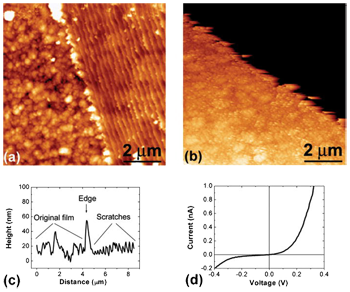
Abstract
We demonstrate that the microstructure and electrical properties of Ge2Sb2Te5 films can be changed by a nanoscale mechanical process. Nanoscratching is used to define modified areas onto an as-deposited crystalline Ge2Sb2Te5 film. Scanning tunneling microscopy measurements show that the modified areas have a very low electrical conductivity. Micro-Raman measurements indicate that the mechanically induced microstructural changes are consistent with a phase transformation from crystalline to amorphous, which can be reversed by laser irradiation.
Enero, 2012 · DOI: 10.1063/1.3673592
Materiales Ópticos Multifuncionales
Collective osmotic shock in ordered materials
Paul Zavala-Rivera, Kevin Channon, Vincent Nguyen, Easan Sivaniah, Dinesh Kabra, Richard H. Friend, S. K. Nataraj, Shaheen A. Al-Muhtaseb, Alexander Hexemer, Mauricio E. Calvo & Hernan MiguezNature Materials, 11 (2012) 53–57 DOI: 10.1038/nmat3179
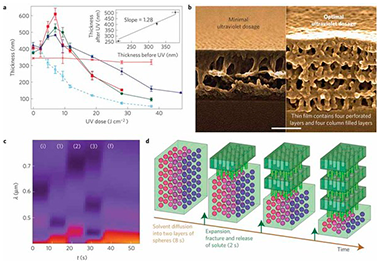
Abstract
Osmotic shock in a vesicle or cell is the stress build-up and subsequent rupture of the phospholipid membrane that occurs when a relatively high concentration of salt is unable to cross the membrane and instead an inflow of water alleviates the salt concentration gradient. This is a well-known failure mechanism for cells and vesicles (for example, hypotonic shock) and metal alloys (for example, hydrogen embrittlement). We propose the concept of collective osmotic shock, whereby a coordinated explosive fracture resulting from multiplexing the singular effects of osmotic shock at discrete sites within an ordered material results in regular bicontinuous structures. The concept is demonstrated here using self-assembled block copolymer micelles, yet it is applicable to organized heterogeneous materials where a minority component can be selectively degraded and solvated whilst ensconced in a matrix capable of plastic deformation. We discuss the application of these self-supported, perforated multilayer materials in photonics, nanofiltration and optoelectronics.
Enero, 2012 · DOI: 10.1038/nmat3179
Materiales Nanoestructurados y Microestructura
Influence of silver content on the tribomechanical behavior on Ag-TiCN bioactive coatings
Sanchez-Lopez, JC; Abad, MD; Carvalho, I; Galindo, RE; Benito, N; Ribeiro, S; Henriques, M; Cavaleiro, A; Carvalho, SSurface and Coatings Technology, 206 (2012) 2192-2198 DOI: 10.1016/j.surfcoat.2011.09.059
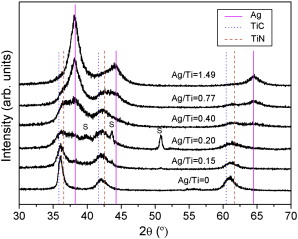
Abstract
Surface modification of bulk materials used in biomedical applications has become an important prerequisite for better biocompatibility. In particular, to overcome the particle generation, low-wear coatings based on carbon (nitrogen) and containing antimicrobial elements such as silver are promising candidates. Thus, the present work explores the potentialities of silver-containing carbonitride-based (Ag-TiCN) thin films prepared by direct current unbalanced reactive magnetron sputtering. The silver content in the coatings was varied from 0 to 26.7at.% by changing the targets and the fraction of C 2H 2 and N 2 in the gas mixture with Ar. The obtained Ag-TiCN based coatings were characterized in terms of composition and microstructure. Mechanical and tribological properties of the films were studied by nanoindentation and reciprocating pin-on disk testing in a fetal bovine serum solution, respectively. Raman, scanning electron microscope and energy dispersive X-ray analysis was carried out in the contact region after tribological tests to obtain information about the friction mechanism. The cytotoxicity of the coatings was assessed by in vitro tests using fibroblast cells. The coatings comprised a mixture of TiC xN 1-x, Ag and a-C(N) x phases whose relative proportion varied depending on the Ag/Ti ratio. The mechanical, tribological and cytotoxicity properties were correlated with the chemical and phase composition. When the Ag/Ti ratios were below 0.20 (Ag contents <6.3at.%) the films resulted harder (~18GPa) with higher wear resistance (~10 -6mm 3/Nm), showing similar friction coefficient (~0.3) and good biocompatibility.
Enero, 2012 · DOI: 10.1016/j.surfcoat.2011.09.059
Nanotecnología en Superficies y Plasma
Analysis of multifunctional titanium oxycarbide films as a function of oxygen addition
Chappe, JM; Fernandes, AC; Moura, C; Alves, E; Barradas, NP; Martin, N; Espinos, JP; Vaz, FSurface and Coatings Technology, 206 (2012) 2525-2534 DOI: 10.1016/j.surfcoat.2011.11.005
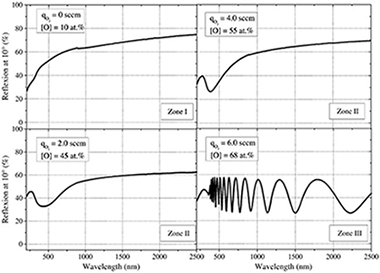
Abstract
Reactive magnetron sputtering was used to deposit titanium oxycarbide thin films. The overall set of results showed that the oxygen flow rate, and thus the composition of the atmosphere in the deposition chamber, controls the composition of the titanium oxycarbide thin films obtained by reactive sputtering. Rutherford Backscattering Spectroscopy analysis revealed the existence of three major types of films, indexed to their particular composition ratios. A detailed study by X-ray photoelectron spectroscopy was carried out in order to characterize the evolution of the Ti


Enero, 2012 · DOI: 10.1016/j.surfcoat.2011.11.005
Nanotecnología en Superficies y Plasma
Adsorption Geometry Determines Catalytic Selectivity in Highly Chemoselective Hydrogenation of Crotonaldehyde on Ag(111)
Brandt, Katrin; Chiu, May E.; Watson, David J.; Tikhov, Mintcho S.; Lambert, Richard M.Journal of Physical Chemistry C, 116 (2012) 4605-4611 DOI: 10.1021/jp208831h
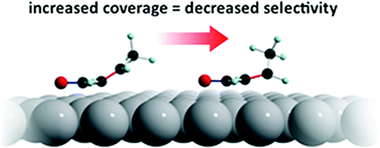
Abstract
The chemoselective hydrogenation of crotonaldehyde to crotyl alcohol was studied by temperature-programmed desorption/reaction, high-resolution XPS, and NEXAFS. The organic molecule adsorbed without decomposition, all three possible hydrogenation products were formed and desorbed, and the clean overall reaction led to no carbon deposition. Selectivities up to 95% were found under TPR conditions. The observed behavior corresponded well with selectivity trends previously reported for Ag/SiO2 catalysts, and the present findings permit a rationalization of the catalytic performance in terms of pronounced coverage-dependent changes in adsorption geometries of the reactant and the products. Thus, at low coverages, the C═O bond in crotonaldehyde lies almost parallel to the metal surface, whereas the C═C was appreciably tilted, favoring hydrogenation of the former and disfavoring hydrogenation of the latter. With increasing coverage of reactants, the C═C bond was forced almost parallel to the surface, rendering it vulnerable to hydrogenation, thus markedly decreasing selectivity toward formation of crotyl alcohol. Butanol formation was the result of an overall two-step process: crotonaldehyde → crotyl alcohol → butanol, further hydrogenation of the desired product crotyl alcohol being promoted at high hydrogen coverage due to the C═C bond in the unsaturated alcohol being driven from a tilted to a flat-lying geometry. Finally, an explanation is offered for the strikingly different behavior of Ag(111) and Cu(111) in the chemoselective hydrogenation of crotonaldehyde in terms of the different degrees of charge transfer from metal to C═O π bond, as suggested by C 1s XPS binding energies.
Enero, 2012 · DOI: 10.1021/jp208831h
Analysis of the restoration of an historical organ: The case study of the Cavaillé-Coll organ of La Merced Church in Burgos, Spain
Justo-Estebaranz, A; Herrera, LK; Duran, A; Siguenza, B; de Haro, MCJ; Laguna, O; Justo, AStudies in Conservation, 57 (2012) 21-28 DOI: 10.1179/2047058411Y.0000000001
Abstract
The restoration of the Cavaille-Coll Romantic organ housed in La Merced Church of Burgos, Spain is described in this paper. The organ was affected by a fire that took place in the church. The effect of the fire on the pipes differed depending on their location within the instrument. A combination of analytical techniques (X-ray diffraction, scanning electron microscopy with energy-dispersive X-ray analysis, particle-induced X-ray emission, metallography, and specific density) allowed the accurate determination of the microstructures and compositions of the alloys used to make the different pipes of the organ, some of which had a high tin content and others which had a high lead content. The most damaged pipes were replaced by reconstructed pipes made out of metallic sheets of the same composition as the originals, to ensure a historically accurate sound.
Enero, 2012 · DOI: 10.1179/2047058411Y.0000000001
Degradation of Two Historic Buildings in Northern Spain by Formation of Oxalate and Sulphate-Based Compounds
Duran, A; Robador, MD; Perez-Rodriguez, JLInternational Journal of Architectural Heritage, 6 (2012) 342-358 DOI: 10.1080/15583058.2010.551447
Abstract
This study focused on the degradation processes for two historic buildings, one in a rural and one in an urban environment. Samples collected from the Romanesque Church of Torme and from two areas of the Cathedral of Burgos were studied by using optical and electron microscopy, x-ray spectrometry, x-ray diffraction, Fourier transform infrared spectroscopy and thermal analysis (TG/DTA/DTG). As result of the action of microorganisms, weddellite and whewellite were found to have formed over the entire external walls of the Church of Torme, built with dolomitic rock. Gypsum, formed by the effects of atmospheric pollution, appeared on lime plasters applied as protective coatings on the external stones of Burgos' Cathedral. Also discussed in this study is the different composition of these plasters, based on the use of calcareous and siliceous aggregates.
Enero, 2012 · DOI: 10.1080/15583058.2010.551447
Química de Superficies y Catálisis
Preferential oxidation of CO (CO-PROX) over CuOx/CeO2 coated microchannel reactor
Laguna, OH; Ngassa, EM; Oraa, S; Alvarez, A; Dominguez, MI; Romero-Sarria, F; Arzamendi, G; Gandia, LM; Centeno, MA; Odriozola, JACatalysis Today, 180 (2012) 105-110 DOI: 10.1016/j.cattod.2011.03.024

Abstract
The general aspects of the synthesis and characterization results of a CuO x/CeO 2 catalyst were presented. In addition the principal steps for manufacturing a microchannel reactor and for the coating of the CuO x/CeO 2 catalyst onto the microchannels walls, were also summarized. The catalytic activity of this microchannel reactor during the preferential oxidation of CO (CO-PROX) was evaluated employing a feed-stream that simulates a reformate off-gas after the WGS unit. Two activation atmospheres were studied (H 2/N 2 and O 2/N 2). The reducing pretreatment improved the resistance to deactivation by formation of carbonaceous species over the catalyst surface at high temperatures. The presence of H 2O and CO 2 in the feed-stream was also analyzed indicating that the adsorption of CO 2 inhibited the conversion of CO at lower temperatures because these compounds modified the active sites through the formation of carbonaceous species on the catalyst surface. Finally, the experimental results of the microreactor performance were compared with CFD simulations that were carried out using a kinetic for the CuO x/CeO 2 powder catalyst. The experimental results were reasonably well described by the model, thus confirming its validity.
Enero, 2012 · DOI: 10.1016/j.cattod.2011.03.024
Materiales de Diseño para la Energía y Medioambiente
Microstructure, composition and P-T conditions of rutile from diamondiferous gneiss of the Saxonian Erzgebirge, Germany
Escudero, A; Miyajima, N; Langenhorst, FChemie der erde-geochemistry, 72 (2012) 25-30 DOI: 10.1016/j.chemer.2011.11.001

Abstract
The chemical composition and microstructure of rutile grains in a ultra-high pressure metamorphic gneiss of the Saxonian Erzgebirge, Germany have been studied by Raman spectroscopy, SEM, EMPA and TEM. Rutile inclusions in garnet contain free dislocations, iron-enriched dislocations and exsolved ilmenite lamellae, while subgrain boundaries are observed in rutile grains of the rock matrix. The previously reported alpha-PbO2 type TiO2 phase could not be confirmed by our TEM observations. On the basis of Zr solubility in the rutile and the presence of microdiamonds, minimum metamorphic peak conditions of 3.95 GPa and 915 degrees C are estimated.
Enero, 2012 · DOI: 10.1016/j.chemer.2011.11.001
Química de Superficies y Catálisis
DRIFTS study of methanol adsorption on Mg-Al hydrotalcite catalysts for the transesterification of vegetable oils
Navajas, A; Arzamendi, G; Romero-Sarria, F; Centeno, MA; Odriozola, JA; Gandia, LMCatalysis Communications, 7 (2012) 189-193 DOI: 10.1016/j.catcom.2011.11.005

Abstract
Mg-Al hydrotalcites rehydrated after calcination are promising catalysts for the methanolysis of vegetable oils. To gain insight into the basis of their catalytic action, the adsorption of methanol over some commercial Mg-Al hydrotalcites was studied by diffuse reflectance infrared Fourier transform spectroscopy (DRIFTS). Different species formed after methanol adsorption were identified, being the total quantity of methoxy species related to the basic character of the sample. A linear correlation between the amount of adsorbed monodentate methoxy species and the catalytic activity in the biodiesel production was found. Therefore, it is proposed that these species are the mainly involved in the transesterification reaction.
Enero, 2012 · DOI: 10.1016/j.catcom.2011.11.005
Reactividad de Sólidos
Non-isothermal microcalorimetric evaluations in quenched and in cold-rolled Cu-9Ni-5.5Sn alloys
Donoso, E; Dianez, MJ; Criado, JMRevista de Metalurgia, 48 (2012) 67-75 DOI: 10.3989/revmetalm.1136
Abstract
The thermal aging of both a quenched and a cold rolled homogeneous supersaturated Cu-9 % wt Ni-5.5 wt % Sn alloy has been studied from differential scanning calorimetry (DSC) and microhardness measurements. An increase of the hardness during the aging of the quenched sample, because of the precipitation of a γ' phase, takes place. On the contrary, no hardness increase was observed during the aging of the cold rolled sample. A theoretical analysis of the enthalpy determined from the first DSC exothermic peak suggests that a segregation of the solute towards the dislocations occurs during the aging of the cold rolled alloy. The values of the n Avrami-Erofeev coefficients estimated from the kinetic analysis supports the above interpretations.
Enero, 2012 · DOI: 10.3989/revmetalm.1136
Nanotecnología en Superficies y Plasma
Superhydrophobic supported Ag-NPs@ZnO-nanorods with photoactivity in the visible range
Macias-Montero, M; Borras, A; Saghi, Z; Romero-Gomez, P; Sanchez-Valencia, JR; Gonzalez, JC; Barranco, A; Midgley, P; Cotrino, J; Gonzalez-Elipe, ARJournal of Materials Chemistry, 22 (2012) 1341-1346 DOI: 10.1039/C1JM13512K

Abstract
In this article we present a new type of 1D nanostructures consisting of supported hollow ZnO nanorods (NRs) decorated with Ag nanoparticles (NPs). The 3D reconstruction by high-angle annular dark field scanning transmission electron microscopy (HAADF-STEM) electron tomography reveals that the Ag NPs are distributed along the hollow interior of the ZnO NRs. Supported and vertically aligned Ag-NPs@ZnO-NRs grow at low temperature (135 °C) by plasma enhanced chemical vapour deposition on heterostructured substrates fabricated by sputtered deposition of silver on flat surfaces of Si wafers, quartz slides or ITO. The growth mechanisms of these structures and their wetting behavior before and after visible light irradiation are critically discussed. The as prepared surfaces are superhydrophobic with water contact angles higher than 150°. These surfaces turn into superhydrophilic with water contact angles lower than 10° after prolonged irradiation under both visible and UV light. The evolution rate of the wetting angle and its dependence on the light characteristics are related to the nanostructure and the presence of silver embedded within the ZnO NRs.
Enero, 2012 · DOI: 10.1039/C1JM13512K
2011
2011
Materiales Ópticos Multifuncionales
Porous one dimensional photonic crystals: novel multifunctional materials for environmental and energy applications
Mauricio E. Calvo, Silvia Colodrero, Nuria Hidalgo, Gabriel Lozano, Carmen López-López, Olalla Sánchez-Sobrado and Hernán MíguezEnergy and Environmental Science, 4 (2011) 4800-4812 DOI: 10.1039/C1EE02081A
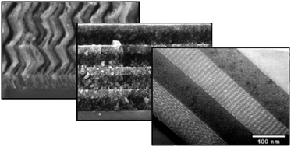
Abstract
In recent times, several synthetic pathways have been developed to create multilayered materials of diverse composition that combine accessible porosity and optical properties of structural origin, i.e., not related to absorption. These materials possess a refractive index that varies periodically along one direction, which gives rise to optical diffraction effects characteristic of Bragg stacks or one-dimensional photonic crystals (1DPCs). The technological potential of such porous optical materials has been demonstrated in various fields related to energy and environmental sciences, such as detection and recognition of targeted biological or chemical species, photovoltaics, or radiation shielding. In all cases, improved performance is achieved as a result of the added functionality porosity brings. In this review, a unified picture of this emerging field is provided.
Diciembre, 2011 · DOI: 10.1039/C1EE02081A
Materiales Coloidales - Nanotecnología en Superficies y Plasma
Synthesis, through pyrolysis of aerosols, of YIn1−xMnxO3 blue pigments and their efficiency for colouring glazes
M. Ocaña, J.P. Espinós, J.B. CardaDyes and Pigments, 91 (2011) 501-507 DOI: 10.1016/j.dyepig.2011.03.009
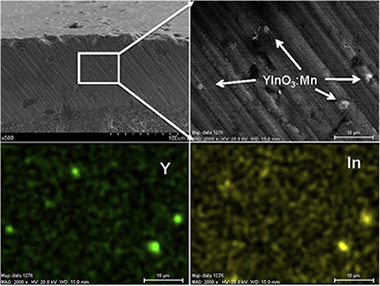
Abstract
Mn-doped YInO3 blue pigments have been synthesised at a much lower temperature (1100 °C) than that required by the traditional solid state method (1400 °C). The developed procedure, which is based on the pyrolysis at 600 °C of aerosols generated from aqueous solutions of Y, In and Mn nitrates followed by an annealing treatment at 1100 °C, yields spherical pigments particles with heterogeneous size in the optimum range required for ceramic applications (<10 μm). The amount of Mn introduced in the YInO3 matrix has been systematically varied in order to evaluate the effects of the Mn content on the colour properties of the pigments. It has been found that the optimum pigment composition (bluer colour with the lowest Mn content) is given by the formula YIn0.90Mn0.10O 3. The technological performance of these YIn1-xMn xO3 blue pigments has also been evaluated by testing their efficiency for colouring ceramic glazes of different composition (boracic and plumbic) and properties, aiming to find a less toxic alternative for the Co-based pigments commonly used by the ceramic industry.
Diciembre, 2011 · DOI: 10.1016/j.dyepig.2011.03.009
Reactividad de Sólidos
An improved model for the kinetic description of the thermal degradation of cellulose
Sanchez-Jimenez, PE; Perez-Maqueda, LA; Perejon, A; Pascual-Cosp, J; Benitez-Guerrero, M; Criado, JMCellulose, 18 (2011) 1487-1498 DOI: 10.1007/s10570-011-9602-3
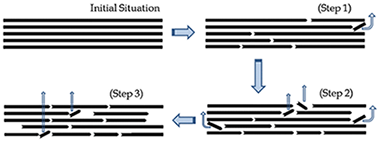
Abstract
In spite of the large amount of work performed by many investigators during last decade, the actual understanding of the kinetics of thermal degradation of cellulose is still largely unexplained. In this paper, recent findings suggesting a nucleation and growth of nuclei mechanism as the main step of cellulose degradation have been reassessed and a more appropriate model involving chain scission and volatilization of fragments has been proposed instead. The kinetics of cellulose pyrolysis have been revisited by making use of a novel kinetic method that, without any previous assumptions regarding the kinetic model, allows performing the kinetic analysis of a set of experimental curves recorded under different heating schedules. The kinetic parameters and kinetic model obtained allows for the reconstruction of the whole set of experimental TG curves.
Diciembre, 2011 · DOI: 10.1007/s10570-011-9602-3
Compositional and Quantitative Microtextural Characterization of Historic Paintings by Micro-X-ray Diffraction and Raman Microscopy
Julia Romero-Pastor, Adrian Duran, Alejandro Basilio Rodríguez-Navarro, René Van Grieken, Carolina CardellAnalytical Chemistry, 83 (2011) 8420-8428 DOI: 10.1021/ac201159e
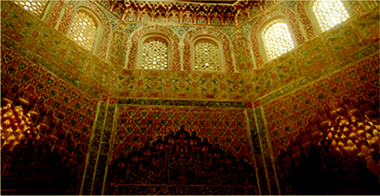
Abstract
This work shows the benefits of characterizing historic paintings via compositional and microtextural data from micro-X-ray diffraction (μ-XRD) combined with molecular information acquired with Raman microscopy (RM) along depth profiles in paint stratigraphies. The novel approach was applied to identify inorganic and organic components from paintings placed at the 14th century Islamic University—Madrasah Yusufiyya—in Granada (Spain), the only Islamic University still standing from the time of Al-Andalus (Islamic Spain). The use of μ-XRD to obtain quantitative microtextural information of crystalline phases provided by two-dimensional diffraction patterns to recognize pigments nature and manufacture, and decay processes in complex paint cross sections, has not been reported yet. A simple Nasrid (14th century) palette made of gypsum, vermilion, and azurite mixed with glue was identified in polychromed stuccos. Here also a Christian intervention was found via the use of smalt, barite, hematite, Brunswick green and gold; oil was the binding media employed. On mural paintings and wood ceilings, more complex palettes dated to the 19th century were found, made of gypsum, anhydrite, barite, dolomite, calcite, lead white, hematite, minium, synthetic ultramarine blue, and black carbon. The identified binders were glue, egg yolk, and oil.
Noviembre, 2011 · DOI: 10.1021/ac201159e
Fotocatálisis Heterogénea: Aplicaciones
Influence of the strong metal support interaction effect (SMSI) of Pt/TiO(2) and Pd/TiO(2) systems in the photocatalytic biohydrogen production from glucose solution
Colmenares, JC; Magdziarz, A; Aramendia, MA; Marinas, A; Marinas, JM; Urbano, FJ; Navio, JACatalysis Communications, 16 (2011) 1-6 DOI: 10.1016/j.catcom.2011.09.003

Abstract
Two different catalysts consisting of Pt/TiO2 and Pd/TiO 2 were submitted to diverse oxidative and reductive calcination treatments and tested for photocatalytic reforming of glucose water solution (as a model of biomass component) in H2 production. Oxidation and reduction at 850°C resulted in better photocatalysts for hydrogen production than Degussa P-25 and the ones prepared at 500°C, despite the fact that the former consisted in very low surface area (6-8 m2/g) rutile titania specimens. The platinum-containing systems prepared at 850°C give the most effective catalysts. XPS characterization of the systems showed that thermal treatment at 850°C resulted in electron transfer from titania to metal particles through the so-called strong metal-support interaction (SMSI) effect. Furthermore, the greater the SMSI effect, the better the catalytic performance. Improvement in photocatalytic behavior is explained in terms of avoidance of electron-hole recombination through the electron transfer from titania to metal particles.
Noviembre, 2011 · DOI: 10.1016/j.catcom.2011.09.003
Materiales de Diseño para la Energía y Medioambiente
Application of the solid state NMR to the study of the alcohol/alkane mixtures adsorption onto graphite
María D. Alba, Miguel A. Castro, Stuart M. Clarke, Santiago Medina, Loic Messe, Carmen MillánSolid State Nuclear Magnetic Resonance, 40 (2011) 138-143 DOI: 10.1016/j.ssnmr.2011.11.002

Abstract
The mixing of molecules adsorbed from solution to different interfaces has both industrial and academic relevance and the mixing behaviour at the interface is a key to understanding for example, that the surface tension of a mixture of two surfactants is lower than either of the two pure materials and many other effects. In this paper, we report, for the first time, the application of Solid State NMR to the study of alkane/alcohol mixtures, in a range of relative size ratio between 0 and 0.35, adsorbed onto graphite at high, multilayer coverage. Moreover, this paper evaluated, for the first time, the utility of the combined used of 1H and 2H NMR for: (i) determining the surface composition and (ii) making a theoretical approach to the sorption isotherm. A variety of preferential adsorption behaviour is reported. Preferential adsorption of the longer molecule (decane vs. heptanol) from a mixture has been observed. However, if both components are of similar length, the alcohol is preferentially adsorbed (heptanol vs. octane and octanol vs. octane). Finally, a linear relation between the relative size ratio and the amount of alcohol at monolayer coverage is observed.
Noviembre, 2011 · DOI: 10.1016/j.ssnmr.2011.11.002
Materiales de Diseño para la Energía y Medioambiente
Structure, Electrical Resistivity, and Thermal Conductivity of Beech Wood Biocarbon Produced at Carbonization Temperatures below 1000 degrees C
Parfen'eva, LS; Orlova, TS; Kartenko, NF; Smirnov, BI; Smirnov, IA; Misiorek, H; Jezowski, A; Muha, J; Vera, MCPhysics of the Solid State, 53 (2011) 2398-2407 DOI: 10.1134/S1063783411110230
Abstract
This paper reports on measurements of the thermal conductivity. and the electrical resistivity. in the temperature range 5-300 K, and, at 300 K, on X-ray diffraction studies of high-porosity (with a channel pore volume fraction of similar to 47 vol %) of the beech wood biocarbon prepared by pyrolysis (carbonization) of tree wood in an argon flow at the carbonization temperature T(carb) = 800 degrees C. It has been shown that the biocarbon template of the samples studied represents essentially a nanocomposite made up of amorphous carbon and nanocrystallites-"graphite fragments" and graphene layers. The sizes of the nanocrystallites forming these nanocomposites have been determined. The dependences rho(T) and kappa(T) have been measured for the samples cut along and perpendicular to the tree growth direction, thus permitting determination of the magnitude of the anisotropy of these parameters. The dependences rho(T) and kappa(T), which have been obtained for beech biocarbon samples prepared at T(carb) = 800 degrees C, are compared with the data amassed by us earlier for samples fabricated at T(carb) = 1000 and 2400 degrees C. The magnitude and temperature dependence of the phonon thermal conductivity of the nanocomposite making up the beech biocarbon template at T(carb) = 800 degrees C have been found.
Noviembre, 2011 · DOI: 10.1134/S1063783411110230
Química de Superficies y Catálisis
Structural and catalytic properties of lanthanide (La, Eu, Gd) doped ceria
Hernandez, WY; Laguna, OH; Centeno, MA; Odriozola, JAJournal of Solid State Chemistry, 184 (2011) 3014-3020 DOI: 10.1016/j.jssc.2011.09.018
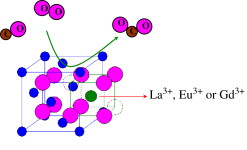
Abstract
Ce0.9M0.1O2-δ mixed oxides (M=La, Eu and Gd) were synthesized by coprecipitation. Independent of the dopant cation, the obtained solids maintain the F-type crystalline structure, characteristic of CeO2 (fluorite structure) without phase segregation. The ceria lattice expands depending on the ionic radii of the dopant cation, as indicated by X-ray diffraction studies. This effect also agrees with the observed shift of the F2g Raman vibrational mode. The presence of the dopant cations in the ceria lattice increases the concentration of structural oxygen vacancies and the reducibility of the redox pair Ce4/Ce3. All synthesized materials show higher catalytic activity for the CO oxidation reaction than that of bare CeO2, being Eu-doped solid the one with the best catalytic performances despite of its lower surface area.
Noviembre, 2011 · DOI: 10.1016/j.jssc.2011.09.018
Química de Superficies y Catálisis
Influence of Al2O3 reinforcement on precipitation kinetic of Cu–Cr nanocomposite
S. Sheibani, A. Ataie, S. Heshmati-Manesh, A. Caballero, J.M. CriadoThermochimica Acta, 526 (2011) 222-228 DOI: 10.1016/j.tca.2011.09.024
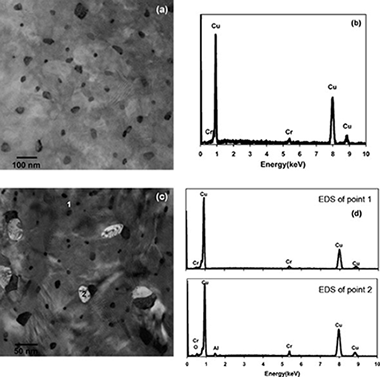
Abstract
In this paper, the kinetic of precipitation process in mechanically alloyed Cu-1 wt.% Cr and Cu-1 wt.% Cr/3 wt.% Al2O3 solid solution was compared using differential scanning calorimetry (DSC), X-ray diffraction (XRD) and transmission electron microscopy (TEM). The ageing kinetics in Cu–Cr and Cu–Cr/Al2O3 can be described using Johnson–Mehl–Avrami (JMA) and Sestak–Berggren (SB) models, respectively. These different behaviors have been discussed in details. It was found that in presence of Al2O3 reinforcement, the ageing activation energy is decreased and the overall ageing process is accelerated. This behavior is probably due to higher dislocation density previously obtained during ball milling and Al2O3–Cu interface. TEM observations confirm that Al2O3–Cu interface and structural defects act as a primary and secondary nucleation sites, respectively.
Noviembre, 2011 · DOI: 10.1016/j.tca.2011.09.024
Materiales de Diseño para la Energía y Medioambiente
Remediation of metal-contaminated soils with the addition of materials – Part I: Characterization and viability studies for the selection of non-hazardous waste materials and silicates
R. González-Núñez, M.D. Alba, M.M. Orta, M. Vidal, A. RigolChemosphere, 85 (2011) 1511-1517 DOI: 10.1016/j.chemosphere.2011.09.042
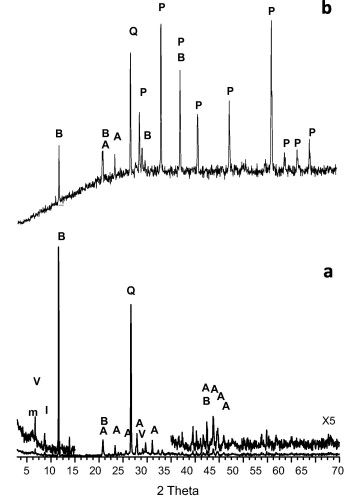
Abstract
Contamination episodes in soils require interventions to attenuate their impact. These actions are often based on the addition of materials to increase contaminant retention in the soil and to dilute the contaminant concentration. Here, non-hazardous wastes (such as sugar foam, fly ash and a material produced by the zeolitization of fly ash) and silicates (including bentonites) were tested and fully characterized in the laboratory to select suitable materials for remediating metal-contaminated soils. Data from X-ray fluorescence (XRF), N2 adsorption/desorption isotherms, X-ray diffraction (XRD) and scanning electron microscopy/energy-dispersive X-ray spectroscopy (SEM–EDX) analyses revealed the chemical composition, specific surface area and the phases appearing in the materials. A pH titration test allowed the calculation of their acid neutralization capacity (ANC). The metal sorption and desorption capacities of the waste materials and silicates were also estimated. Sugar foam, fly ash and the zeolitic material were the best candidate materials. Sugar foam was selected because of its high ANC (17 000 meq kg−1), and the others were selected because of their larger distribution coefficients and lower sorption reversibilities than those predicted in the contaminated soils.
Noviembre, 2011 · DOI: 10.1016/j.chemosphere.2011.09.042
Materiales Nanoestructurados y Microestructura
Electrical properties and applications of carbon based nanocomposite materials: An overview
Sanjinés, R., Abad, M.D., Vâju, C., Smajda, R., Mionić, M., Magrez, A.Surface and Coatings Technology, 206 (2011) 727-733 DOI: 10.1016/j.surfcoat.2011.01.025
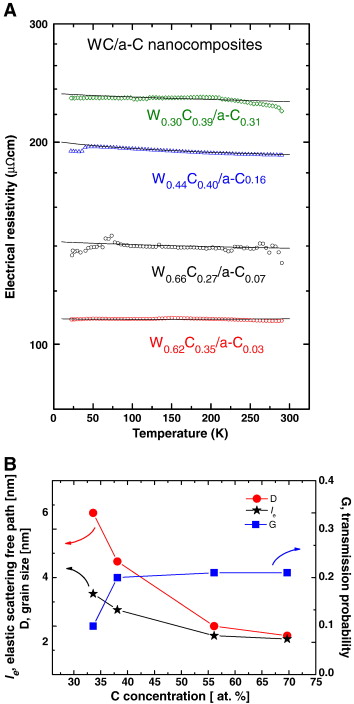
Abstract
The allotropic forms of carbon (amorphous and polycrystalline graphite, carbon black, fullerenes, nanotubes, graphene) exhibit a large variety of charge transport properties which have been stimulating fundamental and applied research for the development of new devices based on micro and nano-sized electronic systems. Carbon based nanocomposites offer the possibility to improve the device performances and to develop novel multifunctional material systems by combining the properties of each individual phase. In this paper we review the electrical properties of carbon materials and some of the most exciting carbon based nanocomposites, as well as their potential technological applications. First, the electrical properties of amorphous and polycrystalline graphitic materials and those of their related nanocomposites materials are discussed. Second, an overview of the state-of-art on research and applications of carbon nanotube-based composites is presented. Third, we discuss briefly the emerging area of research related to graphene materials. Finally, the electrical properties and applications of conducting carbon black aggregates and carbon black/polymer composites are overviewed.
Noviembre, 2011 · DOI: 10.1016/j.surfcoat.2011.01.025
Nanotecnología en Superficies y Plasma
Soft plasma processing of organic nanowires: a route for the fabrication of 1D organic heterostructures and the template synthesis of inorganic 1D nanostructures
Maria Alcaire, Juan R. Sanchez-Valencia, Francisco J. Aparicio, Zineb Saghi, Juan C. Gonzalez-Gonzalez, Angel Barranco, Youssef Oulad Zian, Agustin R. Gonzalez-Elipe, Paul Midgley, Juan P. Espinos, Pierangelo Groening and Ana BorrasNanoscale, 3 (2011) 4554-4559 DOI: 10.1039/C1NR11001B

Abstract
Hierarchical (branched) and hybrid metal-NPs/organic supported NWs are fabricated through controlled plasma processing of metalloporphyrin, metallophthalocyanine and perylene nanowires. The procedure is also applied for the development of a general template route for the synthesis of supported metal and metal oxide nanowires.
Noviembre, 2011 · DOI: 10.1039/C1NR11001B
Química de Superficies y Catálisis
Well-defined negatively charged gold carbonyls on Au/SiO2
Chakarova, K., Mihaylov, M., Ivanova, S., Centeno, M.A., Hadjiivanov, K.Journal of Physical Chemistry C, 115 (2011) 21273-21282 DOI: 10.1021/jp2070562

Abstract
A Au/SiO2 sample was prepared by ammonia-assisted grafting using HAuCl4 as a gold precursor. Gold on the sample evacuated at 673 K is essentially in metallic form: adsorption of CO at 100 K results in formation of Au0-CO species (IR band at 2122 cm-1 shifting to 2103 cm-1 at high coverage). Coadsorption of CO and O2 even at ambient temperature leads to creation of Auδ+ sites and oxidation of CO. On the contrary, increase of the contact time between CO and the sample leads to a gradual reduction of Au0 to Au δ- species. The process is slightly favored by the presence of water and strongly enhanced in the presence of hydrogen. Back oxidation of Auδ- to Au0 and to Auδ+ occurs in the presence of oxygen. The Auδ- sites strongly adsorb CO and form different interconverting carbonyls observed in the 2080-2050 cm -1 region. On the basis of adsorption of CO-13CO and CO-13C18O isotopic mixtures, it is concluded that all Auδ--CO species are linear, and probably ordered structures are formed. Intensity transfer phenomena are nicely monitored during adsorption of CO isotopic mixtures. The eventual role of negatively charged gold in catalysis is discussed.
Noviembre, 2011 · DOI: 10.1021/jp2070562
Nanotecnología en Superficies y Plasma
Comments on "an essay on contact angle measurements": Determination of surface roughness and modeling of the wetting behavior
Terriza, A; Alvarez, R; Yubero, F; Borras, A; Gonzalez-Elipe, ARPlasma Processes and Polymers, 8 (2011) 998-1002 DOI: 10.1002/ppap.201100081
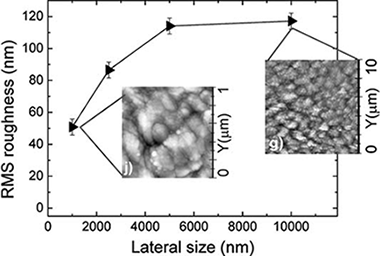
Abstract
This commentary addresses the problem of determining surface roughness values and their use to assess the wetting behavior of surfaces. For very rough surfaces it is shown that depending on the observation scale by atomic force microscopy (AFM) quite different RMS roughness values can be obtained and that only the values taken at saturation can be used for properly describing the roughness of the examined materials. This effect has clear consequences when trying to apply wetting models to account for the influence of roughness on contact angles. These ideas are discussed with examples taken from rough polymer surfaces subjected to plasma etching. Debate - Discussion: To account for the wetting behavior of real surfaces within the Wenzel and similar models only surface roughness values determined at saturation can be used. This implies to check different observation areas by AFM and to choose the RMS roughness values once a maximum value of this parameter has been reached.
Noviembre, 2011 · DOI: 10.1002/ppap.201100081
Reactividad de Sólidos
Formation of the complete range of Ti5Si3-xGex solid solutions via mechanically induced self-sustained reactions
José M. Córdoba, Ernesto Chicardi, Miguel A. Avilés, Francisco J. GotorIntermetallics, 19 (2011) 1688-1692 DOI: 10.1016/j.intermet.2011.07.005
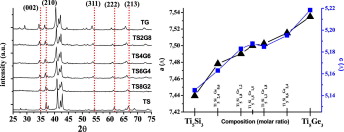
Abstract
The complete range of Ti5Si3–Ti5Ge3 solid solutions was synthesised from elemental mixtures of Ti, Si, and Ge under an inert atmosphere via mechanically induced self-sustaining reactions (MSR). The stoichiometry of Ti5Si3−xGex solid solutions was controlled by adjusting the Si/Ge ratio of the initial mixture. The chemical composition and lattice parameters of the materials confirmed that Ti5Si3–Ti5Ge3 solid solutions with good chemical homogeneity could be produced via MSR.
Noviembre, 2011 · DOI: 10.1016/j.intermet.2011.07.005
Old and modern pigments identification from a 14th century sculpture by Micro-Raman
M. L. Franquelo, A. Duran, D. Arquillo & J. L. Perez-RodriguezSpectroscopy Letters, 44 (2011) 464-468 DOI: 10.1080/00387010.2011.610401
Abstract
The chromatic characterization of the external part of the sculpture showed homogeneity values in the majority of the colored zones. The optical microscopy study showed different layers in the painting cross-sections. The complex polychromy was attributed to several restoration processes carried out along the time. The composition of the different layers of painting cross-sections was studied using the micro-Raman technique. The micro-Raman technique was very useful in characterizing some pigments that are difficult to determine by other experimental techniques. The study showed the presence of several pigments that had been applied in ancient and recent times.
Octubre, 2011 · DOI: 10.1080/00387010.2011.610401
Materiales de Diseño para la Energía y Medioambiente
Structure and Chemical State of Octadecylamine Self-Assembled Monolayers on Mica
Benitez, JJ; San-Miguel, MA; Dominguez-Meister, S; Heredia-Guerrero, JA; Salmeron, MJournal of Physical Chemistry C, 115 (40) (2011) 19716-19723 DOI: 10.1021/jp203871g

Abstract
Structural and chemical data on n-octadecylamine self-assembled monolayers on mica (ODA/mica SAMs) have been obtained from ATR-FTIR and XPS spectroscopies. The analysis of the methylene modes concludes that alkylamine molecules are arranged in a rigid and well-ordered packing. Besides, the magnitude of the splitting of the methylene scissoring deflection is consistent with a molecular tilted configuration within the self-assembled layer, as already reported from topographic AFM data. Molecular dynamics simulations have supported this conclusion. XPS has revealed the presence of an important fraction of protonated amino groups (-NH3+) even in freshly prepared ODA/mica SAMs in air at RT. Two sources of protonation are proposed: (i) the acid-base reaction of (-NH2) end groups with the water adlayer on the surface of hydrophilic mica and (ii) the formation of an alkylamonium alkylcarbamate by a fast reaction with the atmospheric CO2 dissolved in such water adlayer. Though the water induced amino protonation is hypothetical, the presence of carbamate is univocally confirmed by ATR-FTIR. Upon extended contact with air (ripening) the conformational ordering in ODA/mica SAMs is slightly improved. Besides, further amino group protonation takes place with no additional carbamate formation. The process is described by a tentative mechanism in which protons are transferred from water molecules at the edges of SAMs islands to the inside. On the other side, carbamation is hindered by the steric effect of CO2 molecules trying to penetrate the close packed structure of octadecylamine molecules.
Octubre, 2011 · DOI: 10.1021/jp203871g
Materiales de Diseño para la Energía y Medioambiente
The effect of polymorphic structure on the structural and chemical stability of yttrium disilicates
Evgeny Galunin, Miquel Vidal and María D. AlbaAmerican Mineralogist, 96 (2011) 1512-1520 DOI: 10.2138/am.2011.3659
Abstract
Under pressure and temperature conditions like those found in deep geological repositories (DGRs), rare-earth cations may react with silicates to form rare-earth disilicates. This study establishes the stability range of yttrium disilicates in response to changes in pH. The α, β, γ, and δ polymorphs of Y2Si2O7 were synthesized by the sol-gel process at temperatures between 1100 and 1650 °C and subjected to pHstat leaching tests. By measuring the Y and Si leaching rates and monitoring the transformation of the crystalline and amorphous phases, we showed that yttrium disilicates were stable at pH > 5. At pH < 5, the pH stability sequence was consistent with the temperature-dependent stabilities of Y2Si2O7 phases, with the δ polymorph showing the lowest leaching rates. Because rare-earth compounds can be used as a proxy for analogous actinide hosts, the results of this study can be used to predict the performance of engineered barriers in DGR.
Octubre, 2011 · DOI: 10.2138/am.2011.3659
Materiales de Diseño para la Energía y Medioambiente
Evolution of Phases and Al–Si Distribution during Na-4-Mica Synthesis
María D. Alba, Miguel A. Castro, Moisés Naranjo, M. Mar Orta, Esperanza Pavón, and M. Carolina PazosJournal of Physical Chemistry C, 2011, 115 (41), pp 20084–20090 DOI: 10.1021/jp207408h
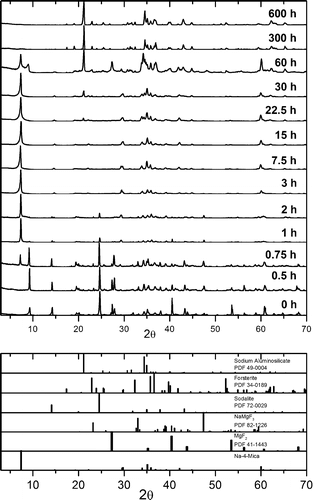
Abstract
Na-4-mica, a highly charged fluorophlogopite, has recently attracted much attention because of its unique combination of high charge (four charges per unit cell) and its swelling and cation-exchange properties. The ability to improve the properties of this mica depends on gaining knowledge about its phase evolution during the calcination process. For the synthesis, the stoichiometric powder mixture (4SiO 2/2Al 2O 3/6MgF 2/8NaCl) was heated to 900 °C for 0-600 h. The obtained solids were characterized by X-ray fluorescence (XRF); X-ray diffraction (XRD); scanning electron microscopy/energy-dispersive X-ray (SEM/EDX) analysis; 29Si, 27Al, and 23Na magic-angle-spinning MAS NMR spectroscopy; and thermogravimetric/differential thermal analysis (TG/DTA). The results showed that the precursors are rapidly (t < 3 h) transformed into sodalite, Al 6Na 8(SiO 4) 6Cl 2, and a 2:1 phyllosilicate. For t = 7.5 h, the amount of 2:1 phyllosilicate increased as a result of the decomposition of sodalite, with a progressive incorporation of aluminum in the 2:1 phyllosilicate being observed. For t = 7.5 h, synthesis of Na-4-mica was considered to be complete, as the material remained essentially unaltered for the next 15 h. For t = 30 h, the mica started to decompose, and for very long reaction times (t ≥ 300 h), only forsterite and a carnegierite phase were present.
Octubre, 2011 · DOI: 10.1021/jp207408h
Materiales Nanoestructurados y Microestructura
Magnetic and fluorescent core-shell nanoparticles for ratiometric pH sensing
Lapresta-Fernández, A., Doussineau, T., Dutz, S., Steiniger, F., Moro, A.J., Mohr, G.J.Nanotechnology, 22 (2011), Article number 415501 DOI: 10.1088/0957-4484/22/41/415501
Abstract
This paper describes the preparation of nanoparticles composed of a magnetic core surrounded by two successive silica shells embedding two fluorophores, showing uniform nanoparticle size (50-60nm in diameter) and shape, which allow ratiometric pH measurements in the pH range 5-8. Uncoated iron oxide magnetic nanoparticles (∼10nm in diameter) were formed by the coprecipitation reaction of ferrous and ferric salts. Then, they were added to a water-in-oil microemulsion where the hydrophilic silica shells were obtained through hydrolysis and condensation of tetraethoxyorthosilicate together with the corresponding silylated dye derivatives - a sulforhodamine was embedded in the inner silica shell and used as the reference dye while a pH-sensitive fluorescein was incorporated in the outer shell as the pH indicator. The magnetic nanoparticles were characterized using vibrating sample magnetometry, dynamic light scattering, transmission electron microscopy, x-ray diffraction and Fourier transform infrared spectroscopy. The relationship between the analytical parameter, that is, the ratio of fluorescence between the sensing and reference dyes versus the pH was adjusted to a sigmoidal fit using a Boltzmann type equation giving an apparent pKa value of 6.8. The fluorescence intensity of the reference dye did not change significantly (∼3.0%) on modifying the pH of the nanoparticle dispersion. Finally, the proposed method was statistically validated against a reference procedure using samples of water and physiological buffer with 2% of horse serum, indicating that there are no significant statistical differences at a 95% confidence level.
Octubre, 2011 · DOI: 10.1088/0957-4484/22/41/415501
Nanotecnología en Superficies y Plasma
Enhanced gas sensing performance of TiO2 functionalized magneto-optical SPR sensors
M.G. Manera, G. Montagna, E. Ferreiro-Vila, L. González-García, J.R. Sánchez-Valencia, A.R. González-Elipe, A.Cebollada, J.M. Garcia-Martin, A. Garcia-Martin, G. Armelles and R. RellaJournal of Materials Chemistry, 21 (2011) 16049-16056 DOI: 10.1039/c1jm11937k
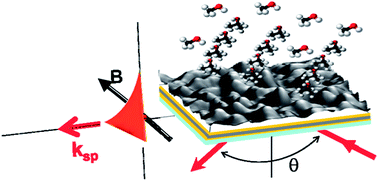
Abstract
Porous TiO2 thin films deposited by glancing angle deposition are used as sensing layers to monitor their sensing capabilities towards Volatile Organic Compounds both in a standard Surface Plasmon Resonance (SPR) sensor and in Magneto-Optical Surface Plasmon Resonance (MO-SPR) configuration in order to compare their sensing performances. Here our results on the enhanced sensing capability of these TiO2 functionalized MO-SPR sensors with Au/Co/Au transducers with respect to traditional SPR gas sensors are presented.
Octubre, 2011 · DOI: 10.1039/c1jm11937k
Nanotecnología en Superficies y Plasma
Colored semi-transparent Cu-Si oxide thin films prepared by magnetron sputtering
Gil-Rosta, J; Yubero, F; Fernandez, R; Vilajoana, T; Artus, P; Dursteler, JC; Cotrino, J; Ortega, I; Gonzalez-Elipe, AROptical Material Express, 1 (2011) 1100-1112 DOI: 10.1364/OME.1.001100
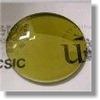
Abstract
Colored semi-transparent Cu-Si oxide thin films have been prepared by reactive magnetron sputtering from a single cathode of copper-silicon composition. Thin films of different composition and optical response were obtained by changing process parameters like the relative amount of copper in the target and the O2/Ar mixture of the reactive plasma gas. The film characteristics were analyzed by several techniques. Their optical properties (refractive index, absorption coefficient, color) have been correlated with the process parameters used in the film preparation as well as with the film stoichiometry and chemistry.
Septiembre, 2011 · DOI: 10.1364/OME.1.001100
Analytical study of Roman and Arabic wall paintings in the Patio De Banderas of Reales Alcazares' Palace using non-destructive XRD/XRF and complementary techniques
Duran, A., Perez-Rodriguez, J.L., Jimenez de Haro, M.C., Franquelo, M.L., Robador, M.D.Journal of Archaeological Science, 38 (2011) 2366-2377 DOI: 10.1016/j.jas.2011.04.021
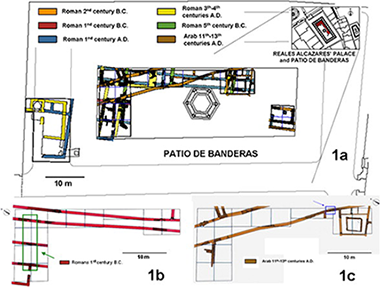
Abstract
A portable XRD/XRF system and complementary laboratory techniques were employed to improve the knowledge of the procedures used to create Roman and Arabic wall paintings. Integrated physico-chemical investigations were conducted on fragments of artworks collected from the archaeological excavation of the Patio de Banderas in the Reales Alcazares' Palace of Seville (Spain), and a comparative study on the pigments from both historical periods was performed. As a result, pigments such as vermilion, red ochre, yellow ochre, green earth, Egyptian blue, carbon and phosphor-based black pigments were detected in Roman samples; however, in the Arabic fragments, only haematite was observed. In addition, the size and shape of the particles of the wall paintings were studied with an XRD 2-dimensional detector and SEM-EDX.
Septiembre, 2011 · DOI: 10.1016/j.jas.2011.04.021
Química de Superficies y Catálisis
CO oxidation at low temperature on Au/CePO4: Mechanistic aspects
Romero-Sarria, F., Domínguez, M.I., Centeno, M.A., Odriozola, J.A.Applied Catalysis B: Environmental, 107 (2011), 268-273 DOI: 10.1016/j.apcatb.2011.07.022
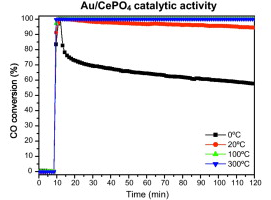
Abstract
This work reports the synthesis and characterization of a cerium phosphate supported gold catalyst as well as its catalytic activity for the oxidation of CO. A precipitation method in the presence of an organic modifier followed by a hydrothermal treatment was used for the support synthesis, resulting in high surface area nanometric particles. Gold/cerium phosphate catalyst with a 1% (w/w) nominal gold content was characterized using XRF, XRD, N2 adsorption-desorption measurements, TEM and DRIFTS-MS. The catalyst shows good catalytic activity at low temperature. The activity is related to the generation of oxygen vacancies in the support caused by the elimination of structural oxygen. In situ studies revealed that the reaction of the oxygen vacancies with gaseous oxygen resulted in the formation of peroxo species. These species are responsible for the activity detected at room temperature in both the catalyst and the support. Moreover, the presence of carbonate and hydrogen carbonate acting as reaction intermediates have been observed.
Septiembre, 2011 · DOI: 10.1016/j.apcatb.2011.07.022
Nanotecnología en Superficies y Plasma
Aligned TiO(2) nanocolumnar layers prepared by PVD-GLAD for transparent dye sensitized solar cells
Gonzalez-Garcia, L; Gonzalez-Valls, I; Lira-Cantu, M; Barranco, A; Gonzalez-Elipe, AREnergy and Environmental Science, 4 (2011) 3426-3435 DOI: 10.1039/C0EE00489H
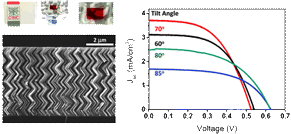
Abstract
Transparent thin film electrodes made of vertically aligned nanocolumns of TiO2 with well-controlled oblique angles were grown by physical vapor deposition at glancing incidence (PVD-GLAD). For an electrode thickness of 500 nm, we report a 40% variation on solar cell efficiency (from 0.6% to 1.04%) when the deposition angle was modified between 60° and 85°. Transparent thicker films with higher surface area deposited at the optimal angle of 70° were grown with a zigzag morphology which confers high mechanical strength to the thin films. Using this topology, the application of an electrode thickness of 3 m in a DSC resulted in a power conversion efficiency of 2.78% maintaining electrode transparency.
Septiembre, 2011 · DOI: 10.1039/C0EE00489H
Fotocatálisis Heterogénea: Aplicaciones
Synthesis, characterization and photocatalytic activity of Bi-doped TiO2 photocatalysts under simulated solar irradiation
Murcia-López, S., Hidalgo, M.C., Navío, J.A.Applied Catalysis A: General, 404 (2011) 59-67 DOI: 10.1016/j.apcata.2011.07.008

Abstract
A series of Bi3+-doped TiO2 catalysts with a doping concentration up to 2 wt% were prepared by a sol-gel hydrothermal method. The prepared photocatalysts were characterized by different techniques to determine their structure, morphology and light absorption properties. The activities were evaluated in the photocatalytic oxidation of phenol in aqueous solution under UV-vis illumination. The experimental results indicate that the presence of Bi3+ in TiO2 catalysts enhances the photocatalytic reaction of phenol degradation, although the efficiency of the process markedly depends on the nominal content of the Bi3+ and on the calcination temperature. It was found that the optimal dosage of 0.5 wt% Bi3+ in TiO2 and calcinations at 600 °C 4 h achieved the fastest reaction of phenol degradation under the experimental conditions. From the comparison of the initial rates of the photocatalytic degradation of phenol between home prepared undoped and Bi3+-doped TiO2 with commercial TiO2 Degussa P25, it can be inferred that home prepared TiO 2 calcined at temperatures above 500 °C clearly exceed the photocatalytic performance of P25. When bismuth is incorporated, the reaction rate values are even higher, especially at 600 °C. Even when Bi 3+-doped TiO2 (0.5 wt% Bi3+) calcined at 600 °C has almost the same BET surface than P25, its activity is better. In particular, the reaction rate for the sample with a 0.5% mass content of Bi 3+ calcined at 600 °C not only present higher value with respect to the other series but also a degree of mineralization close to 100%.
Septiembre, 2011 · DOI: 10.1016/j.apcata.2011.07.008
Nanotecnología en Superficies y Plasma
Theoretical and experimental characterization of TiO2 thin films deposited at oblique angles
Álvarez, R., González-García, L., Romero-Gómez, P., Rico, V., Cotrino, J., Gonzalez-Elipe, A.R., Palmero, A.Journal of Physics D: Applied Physics, 44 (2011) Article number 385302 DOI: 10.1088/0022-3727/44/38/385302
Abstract
The microstructural features of amorphous TiO2 thin films grown by the electron beam physical vapour deposition technique at oblique angles have been experimentally and theoretically studied. The microstructural features of the deposited films were characterized by considering both the column tilt angle and the increase in the column thickness with height. A Monte Carlo model of film growth has been developed that takes into account surface shadowing, short-range interaction between the deposition species and the film surface, as well as the angular broadening of the deposition flux when arriving at the substrate. The good match between simulations and experimental results indicates the importance of these factors in the growth and microstructural development of thin films deposited at oblique angles.
Septiembre, 2011 · DOI: 10.1088/0022-3727/44/38/385302
Química de Superficies y Catálisis
Oxidation of CO over gold supported on Zn-modified ceria catalysts
Laguna, O.H., Centeno, M.A., Romero-Sarria, F., Odriozola, J.A.Catalysis Today, 172 (2011) 118-123 DOI: 10.1016/j.cattod.2011.02.015
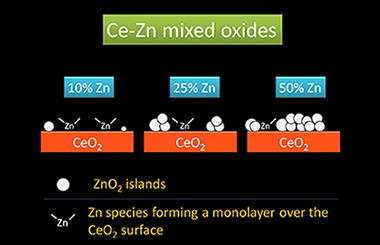
Abstract
A series of Zn-modified ceria solids were prepared by thermal decomposition of the corresponding metal propionates. The formation of segregated ZnO particles on the ceria surface is evidenced for these solids using X-ray diffraction; in addition to this the characterization data may allow discarding the formation of a ZnO-CeO2 solid solution. On modifying with Zn, the reducibility of the ceria support is enhanced, being the highest reducibility the one obtained for the ZnO-CeO2 solid having a 1:9 Zn:Ce atomic ratio (CeZn10). The activity of this solid in the CO oxidation reaction was the highest among the tested Zn-modified ceria solids. Therefore, catalysts containing 1 wt.% gold, supported on pure ceria and CeZn solids, were prepared, characterized and their catalytic activities tested. The Zn-modified gold catalyst is more active than the un-modified Au/CeO2 catalyst in the oxidation of CO; this behavior is related to the higher metallic dispersion of gold on the CeZn support surface. However, the number of oxygen vacancies acting as nucleation sites for gold, is hardly modified in the Zn-modified ceria support and, therefore, the higher gold dispersion must be related to high electron density sites on the catalyst surface as a result of Au-Ce-Zn interaction, this improved gold dispersion results in higher activities for CO oxidation.
Agosto, 2011 · DOI: 10.1016/j.cattod.2011.02.015
Nanotecnología en Superficies y Plasma
Aspects of heterogeneous enantioselective catalysis by metals
Kyriakou, G., Beaumont, S.K., Lambert, R.M.Langmuir, 27 (2011) 9687-9695 DOI: 10.1021/la200009w
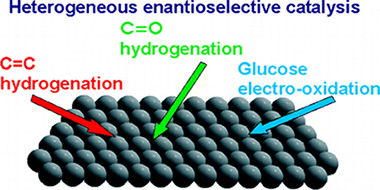
Abstract
Some aspects of metal-catalyzed heterogeneous enantioselective reactions are reviewed with specific reference to four different systems where the phenomena that control enantioselection appear to be very different. In the case of glucose electro-oxidation, it is clear that any intrinsic chirality present at the metal surface plays a vital role. With α-keto hydrogenation, achiral surfaces modified by the adsorption of chiral agents become effective enantioselective catalysts and the formation of extended arrays of chiral species appears not to be of importance: instead a 1:1 docking interaction controlled by hydrogen bonding between the adsorbed chiral modifier and the prochiral reactant determines the outcome. Hydrogen bonding also plays a central role in β-ketoester hydrogenation, but here fundamental studies indicate that the formation of ordered arrays involving the reactant and chiral ligand is of importance. Asymmetric C=C hydrogenation, though relatively little studied, has the potential for major impact in synthetic organic chemistry both on the laboratory scale and in the manufacture of fine chemicals and pharmaceuticals. The structural attributes that determine whether a given chiral ligand is effective have been identified; the ability to form strong covalent bonds with the metal surface while also resisting hydrogenation and displacement by the strongly adsorbing reactant under reaction conditions is an essential necessary condition. Beyond this, ligand rigidity in the vicinity of the chirality center coupled with resistance to SAM formation is a critically important factor whose absence results in racemic chemistry.
Agosto, 2011 · DOI: 10.1021/la200009w
Materiales Coloidales - Materiales Ópticos Multifuncionales
Angular emission properties of a layer of rare-earth based nanophosphors embedded in one-dimensional photonic crystal coatings
Sánchez-Sobrado, O., Yacomotti, A.M., Calvo, M.E., Martínez, O.E., Ocaña, M., Núñez, N., Levenson, J.A., Míguez, H.Applied Physics Letters, 99 (2011) Article number 051111 DOI: 10.1063/1.3619814

Abstract
The angular properties of light emitted from rare-earth based nanophosphors embedded in optical resonators built in one-dimensional photonic crystal coatings are herein investigated. Strong directional dependence of the photoluminescence spectra is found. Abrupt angular variations of the enhancement caused by the photonic structure and the extraction power are observed, in good agreement with calculated polar emission patterns. Our results confirm that the optical cavity favors the extraction of different wavelengths at different angles and that integration of nanophosphors within photonic crystals provides control over the directional emission properties that could be put into practice in phosphorescent displays.
Agosto, 2011 · DOI: 10.1063/1.3619814
Materiales de Diseño para la Energía y Medioambiente
Structural elucidation of Β-(Y,Sc)2Si2O 7: Combined use of 89Y MAS NMR and powder diffraction
Allix, M., Alba, M.D., Florian, P., Fernandez-Carrion, A.J., Suchomel, M.R., Escudero, A., Suard, E., Becerro, A.I.Journal of Applied Crystallography, 44 (2011) 846-852 DOI: 10.1107/S0021889811021303
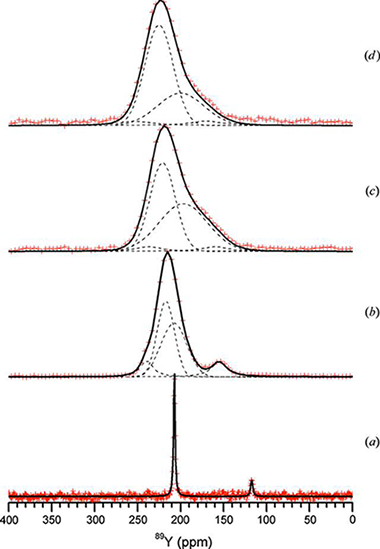
Abstract
Although the structures of pure Sc2Si2O7 and Β-Y2Si 2O7 have been described in the literature using the C2/m space group, 29Si magic angle spinning (MAS) NMR measurements of the intermediate members of the Sc2Si2O7-Β- Y2Si2O7 system indicate a lowering of the symmetry to the C2 space group. Indeed, these compositions exhibit a unique Si crystallographic site and an Si-O-Si angle lower than 180°, incompatible with the C2/m space group. C2 is the only possible alternative. Space group Cm can be discarded with regard to its two different Si sites per unit cell. Moreover, 89Y MAS NMR data have revealed the existence of two different Y sites in the structure of the intermediate members of the Sc 2Si2O7-Β-Y2Si2O 7 system, confirming the lowering of the symmetry to the C2 space group. The viability of the C2 model has therefore been tested and confirmed by refinement of synchrotron and neutron powder diffraction data for the different members of the system. The structural evolutions across the Sc 2Si2O7-Β-Y2Si2O 7 system are discussed.
Agosto, 2011 · DOI: 10.1107/S0021889811021303
Materiales de Diseño para la Energía y Medioambiente
Formation of organo-highly charged mica
Alba, M.D. , Castro, M.A., Orta, M.M., Pavón, E., Pazos, M.C., Valencia Rios, J.S.Langmuir, 16 (2011) 9711-9718 DOI: 10.1021/la200942u

Abstract
The interlayer space of the highly charged synthetic Na-Mica-4 can be modified by ion-exchange reactions involving the exchange of inorganic Na + cations by surfactant molecules, which results in the formation of an organophilic interlayer space. The swelling and structural properties of this highly charged mica upon intercalation with n-alkylammonium (RNH 3) + cations with varying alkyl chain lengths (R = C12, C14, C16, and C18) have been reported. The stability, fine structure, and evolution of gaseous species from alkylammonium Mica-4 are investigated in detail by conventional thermogravimetric analysis (TGA), Fourier transform infrared spectroscopy (FTIR), in situ X-ray diffraction (XRD), and solid-state nuclear magnetic resonance (MAS NMR) techniques. The results clearly show the total adsorption of n-alkylammonium cations in the interlayer space which expands as needed to accommodate intercalated surfactants. The surfactant packing is quite ordered at room temperature, mainly involving a paraffin-type bilayer with an all-trans conformation, in agreement with the high density of the organic compounds in the interlayer space. At temperatures above 160 °C, the surfactant molecules undergo a transformation that leads to a liquid-like conformation, which results in a more disordered phase and expansion of the interlayer space.
Agosto, 2011 · DOI: 10.1021/la200942u
Materiales Nanoestructurados y Microestructura
Boron Compounds as Stabilizers of a Complex Microstructure in a Co-B-based Catalyst for NaBH4 Hydrolysis
Arzac, G.M., Rojas, T.C., Fernández, A.ChemCatChem, 3 (2011) 1305-1313 DOI: 10.1002/cctc.201100101
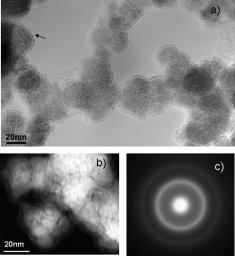
Abstract
Co-B-based materials are widely used as catalysts for hydrogen generation through sodium borohydride self-decomposition. In the mid 1990s, the aqueous and organic chemistry involved in Co-B synthesis and handling was studied. Nevertheless, the exact microstructure of these catalysts has remained unsolved. Herein we present an exhaustive study which shows a new and complete microstructural view of a Co-B-based material together with the chemistry of the cobalt and boron involved. By using nanoscale-resolution microscopy and spectroscopy techniques, we have elucidated the role of boron compounds as stabilizers in a complex microstructure, which also explains its high catalytic performance and long-term stability. The catalyst is proposed to be made up of 1-3nm hcp Co0 nanoparticles embedded in amorphous CoxB (x=1, 2, 3), CoxOy, Co(BO2)2, and B2O3 phases alternatively or all together. All of these amorphous phases protect the nanocrystalline metallic core from growth and oxidation.
Agosto, 2011 · DOI: 10.1002/cctc.201100101
Química de Superficies y Catálisis
Fe-doped ceria solids synthesized by the microemulsion method for CO oxidation reactions
O.H. Laguna, M.A. Centeno, M. Boutonnet, J.A. OdriozolaApplied Catalysis B: Environmental, 106 (2011) 621-629 DOI: 10.1016/j.apcatb.2011.06.025
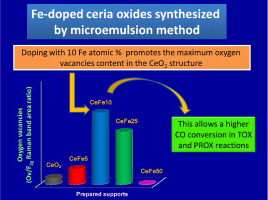
Abstract
A series of Ce-Fe mixed oxides as well as the pure oxides were synthesized by the microemulsions method. The solid solution formation was established for all the Fe-doped systems and only a hardly noticeable segregation of α-Fe2O3 was appreciated for the solid with the maximum iron content (50at.% Fe). The oxygen exchange is improved for all the Fe-doped systems; however the 10at.% Fe appears as the optimal iron content for achieving the maximum oxygen vacancies concentration and the higher reducibility efficiency. The CO oxidation (TOX, PROX) is especially achieved for the solids with the lower iron contents but with a superior oxygen vacancies proportion. These Ce-Fe systems prepared from microemulsions are very attractive to be considered as supports for depositing active phases capable of enhancing oxygen exchange ability of the whole system, allowing higher CO oxidation abilities.
Agosto, 2011 · DOI: 10.1016/j.apcatb.2011.06.025
Química de Superficies y Catálisis
Ionic liquid protected heteropoly acids for methanol dehydration
Ivanova, S., Nitsch, X., Romero-Sarria, F., Louis, B., Centeno, M.A., Roger, A.C., Odriozola, J.A.Catalysis Today, 171 (2011) 236-241 DOI: 10.1016/j.cattod.2011.03.077
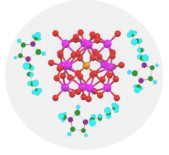
Abstract
We report herein the synthesis of an organic-inorganic hybrid composed by the ionic liquid protected Keggin structure, as a precursor for acid catalyst and its subsequent application in the methanol dehydration reaction. Special attention was paid to the thermal stability of the resulted hybrids as a function of the Keggin anion. The catalytic behaviour of these new materials are also studied and compared to the metal salt Cs2HPW 12O40. The prepared hybrids are less thermally stable than the metal salt, but their partial decomposition results in very active and selective catalysts for the dehydration of methanol to dimethyl ether.
Agosto, 2011 · DOI: 10.1016/j.cattod.2011.03.077
- ‹ anterior
- 30 of 36
- siguiente ›














